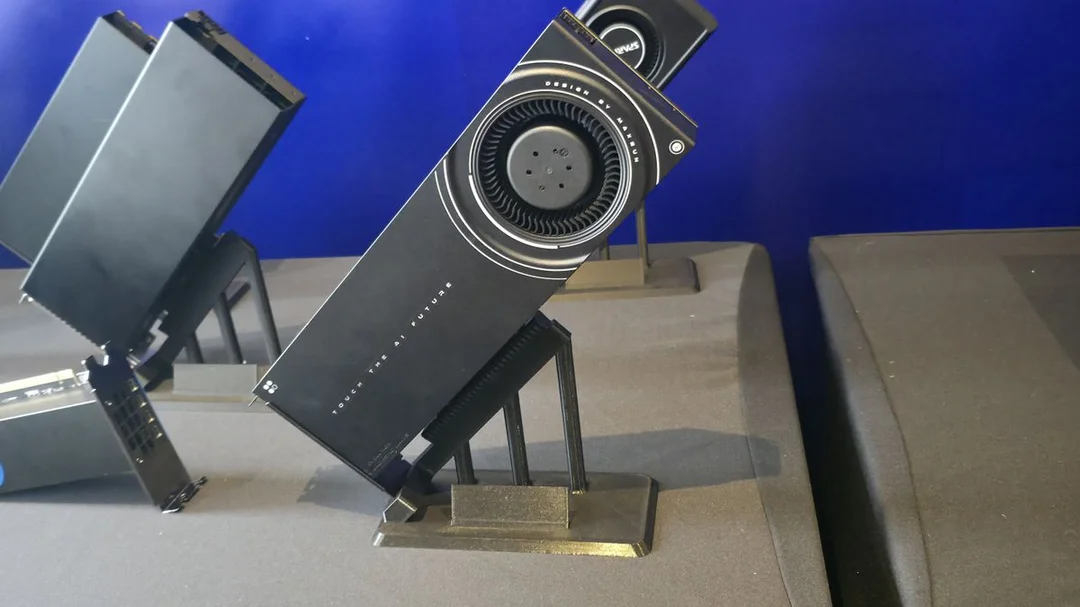
Intel’s Arc Pro B-Series Aims to Disrupt Workstation GPU Market with High Memory and Competitive Pricing
Intel is making a bold move into the workstation GPU market with its new Arc Pro B-series, unveiled at Computex 2025. These cards are designed to offer high memory capacity at competitive prices, potentially disrupting the dominance of industry giants like Nvidia. With a focus on AI inference and professional graphics tasks, the Arc Pro B50 and B60 are poised to offer a compelling alternative for professionals and smaller AI server clusters.

Arc Pro B50: Compact Power for Workstations
The Intel Arc Pro B50 is a compact, dual-slot card designed for slim workstations. It boasts 16GB of VRAM and a 70W TBP, making it an efficient addition to small-form-factor systems. According to Intel, the B50 delivers up to 170 peak TOPS, thanks to its 16 Xe cores and 128 XMX engines. The card also features a PCIe 5.0 x8 interface, which Intel claims significantly speeds up transfers from system memory. The $299 price tag is definitely interesting given the memory offering.
The 16GB of memory sets the B50 apart from its competitors, which typically offer 6 or 8GB in this segment. Intel also highlights the card's certified drivers, claiming they deliver up to 2.6X more performance than baseline gaming drivers.
Arc Pro B60: Powering AI Inference Workstations
Stepping up the performance, the Intel Arc Pro B60 comes equipped with 24GB of VRAM, 20 Xe cores, and 160 XMX engines, delivering 197 peak TOPS. It fits into a 120 to 200W TBP envelope and also features a PCIe 5.0 x8 interface. The B60 is primarily targeted at AI inference workstations, including those under the "Project Battlematrix" initiative. Some sources estimate per-unit cost will be in the range of $500 per GPU.
The additional memory capacity of the B60 allows it to handle larger models and more concurrent tasks, making it suitable for demanding AI workloads. Intel's benchmarks claim gains of up to 2.7X over competing GPUs in various AI models, primarily by increasing model size, context, and concurrency scaling.
Project Battlematrix: A Full-Stack Solution
Intel's Project Battlematrix aims to provide a cohesive workstation solution by combining hardware and software. These Xeon-powered workstations can house up to eight GPUs, 192GB of total VRAM, and support models with over 70B parameters. Intel is also developing a validated full-stack containerized Linux solution, complete with optimized drivers, libraries, tools, and frameworks, simplifying deployment for users.
Competition and the Path Forward
According to figures, a dual-GPU card featuring two B60 chips with a combined 48GB of memory could land near $1,000. For comparison, Nvidia's RTX 6000 Ada, with the same 48GB of VRAM, sells for over $5,500. Two of those cards can push costs north of $18,000.

However, Intel faces challenges in the professional market, where Nvidia is favored for its mature drivers and software optimization. While the Arc Pro B-series offers a compelling price-to-performance ratio, Intel needs to demonstrate its reliability and optimization in real-world professional applications, especially for Linux virtualization. Currently Intel is in the enablement phase, with ISV certification and initial container deployments coming in Q3.
The Future of Workstation Graphics?
Intel's Arc Pro B-series represents a significant step in challenging the established workstation GPU market. By prioritizing memory capacity and offering competitive pricing, Intel aims to carve out a niche for itself, particularly in AI inference and virtualized environments. Will Intel's gamble pay off, and can it convince professionals to switch from established brands like Nvidia, or smaller AI server clusters? What are your thoughts on these new cards?
Leave your comments below and share your perspective on the future of workstation graphics.